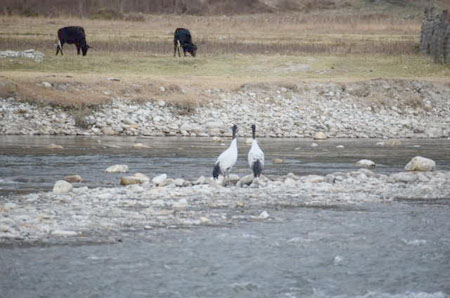[ Tongam Rina ]
ITANAGAR, Dec 5: The sacred black-necked crane has arrived in Sangti, the second known wintering site near Dirang in West Kameng district.
Two cranes arrived on 4 December along Sangti Chu, one of the two wintering sites in Arunachal. The other site is Pangcheng valley in Tawang.
Speaking to this daily, Dorjee Leto, an entrepreneur who is from Sangti Village (close to Sangti Chu), said cranes had attempted to land a few days ago but because of paragliding in the area by the National Institute of Mountaineering and Allied Sports (NIMAS), Dirang, the birds returned.
They finally returned after the villagers requested the NIMAS to stop paragliding in the area from November to March so that movement of the cranes is not disturbed.
Between 2009-13, not a single crane had come to the Sangti valley. Experts say that it was because of habitat destruction and a change in the cultivation pattern in that area. High tension power lines also run through the entire stretch of the habitation of cranes.
In 2016, two cranes were killed when they were snagged on a high-voltage power line in the Sangti Valley – the second such incident since 2007.
Apart from habitat destruction, there are other threats for the cranes to stay away from Sangti Valley.
In 2008, a black-necked crane was killed by an Arunachalee government employee who was not from the area, locals say.
The government employee was not aware about the crane and its religious and cultural importance so we did not lodge a complaint, a villager said.
The timings of the arrival of the cranes have changed too.
Experts say that cranes usually arrive during late October or early November, and depart in late March or early April, but according to locals, the pattern has changed.
Dorjee Leto says that cranes usually come in mid November and leave by February-March, depending on the weather condition.
This time they came in the first week of December.
They leave when it starts to get warm and it is getting much warmer in Sangti Valley, so the cranes may leave early, he said.
Other than the rising temperature, human encroachment of the habitat of the cranes has also been responsible for cranes abandoning the state.
The Apatani Valley was once the favourite site of these birds. According to Daniel Mize, from the Centre with Potential for Excellence in Biodiversity, Rajiv Gandhi University, a record 27 cranes visited Ziro in the Apatani Valley in 1954. But they have not been seen in that region since the seventies.
Mize, who has been studying the black-necked cranes across the state, has said that the cranes were spotted in the rice fields of the Chug Valley and at Doblo River in Shergoan in West Kameng between 2016-2017.
While the high tension wires have claimed lives of the cranes in Sangti, in Bhutan, electrification is underground in all the crane wintering sites, a policy which could be replicated in Arunachal.
Earlier, the magnificent cranes flew into in its wintering abode in the Pangcheng valley along the Nyamjang Chhu River, Zemithang in Tawang district on 3 December. The cranes could not land in Pangcheng valley last year, though it attempted. Conservationists say it was because of habitat destruction due to massive sand mining and blasting for road construction.
A short 3-km stretch of the Nyamjang Chhu River between Brokenthang and Zemithang in Tawang district of Arunachal Pradesh is one of the only two regular, long-term wintering sites of the bird in India.
The cranes are revered among the Monpas as the embodiment of the sixth Dalai Lama, His Holiness Gyalwa Tsangyang Gyatso, born in 1683. He has written about the majestic bird in poetries and has used it as imagery of his return.
The wintering site in Tawang also faced the threat from 780 MW Nyamjang Chhu project by the NHPC Ltd which is currently under suspension because of intervention by the National Green Tribunal.
Following an appeal by the Save Mon Region Federation, the National Green Tribunal in a landmark judgement dated April 7th, 2016 had suspended the environmental clearance granted to the barrage site and submergence as it will destroy the wintering site of the bird.
The Environment Impact Assessment (EIA) had failed to record the importance of the wintering site and did not mention the black-necked crane even once in its report.
The birds that fly in from Tibet at the end of every year are protected under Schedule-I of the Wildlife (Protection) Act, 1972 and are in the ‘vulnerable category’ as per the IUCN.
According to Wildlife International, there are around 11,000 such cranes in the world.





